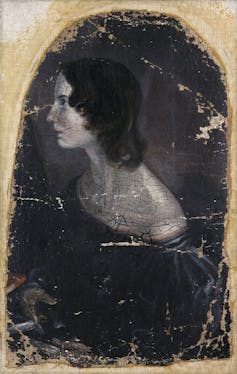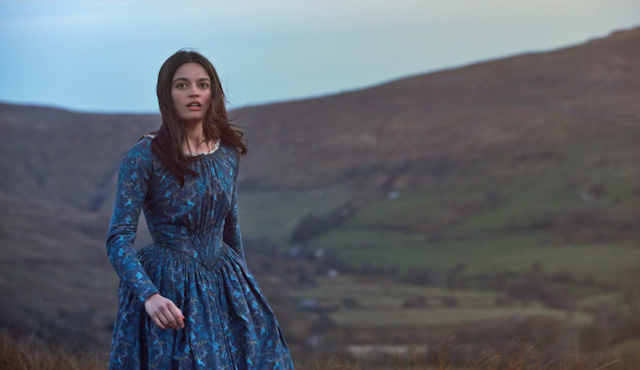When Emily Brontë published Wuthering Heights in 1847 under the pseudonym Ellis Bell, outraged Victorian critics deemed it savage, indecent and immoral. One described it as “a compound of vulgar depravity and unnatural horrors”.
After Brontë’s death, when the novel began to find success, many were surprised to find that such a tempestuous gothic romance had been written by a quiet parson’s daughter. But did a real-life romance inspire Emily Brontë’s only novel? According to Frances O’Connor’s new film, Emily, the answer is yes. But the historical picture is far more murky.
The film presents a romantic origin story to account for Brontë’s iconic novel. While reclaiming Emily as a rebel, misfit and the weirdest of the “weird sisters”, as Ted Hughes memorably called them, the film departs knowingly from historical fact, mixing biography with Brontë mythology and dramatic invention to present a very different picture. Australian-British director O'Connor has described her film as putting Emily at the centre of her own story.
This Emily is a rum-and-gin-drinking, opium-fuelled young woman, whose life was, in O'Connor’s vision, a version of Wuthering Heights. As one reviewer put it, “Emily isn’t a biopic of Emily Brontë but a fantastical retelling of her life.”
Because the bond between the novel’s Catherine Earnshaw and Heathcliff is widely considered one of the most passionate stories in English Literature, people doubt whether an unmarried clergyman’s daughter could have written it without experiencing romance first hand.
O'Connor’s film suggests that a passionate but tragic affair between Brontë and the local curate, William Weightman, is the source for Cathy and Heathcliff’s bond. Their romance is portrayed as a heated one, with the couple’s sexual intimacy troubling Weightman’s religious beliefs.
Who was William Weightman?
Weightman has featured prominently in stories of the Brontës’ romantic lives. He was assistant curate to their father, Patrick Brontë, at Haworth’s St Michael and All Angels’ church between 1839 and 1842, and a friend to all the Brontë siblings.
But despite the fervent story in O’Connor’s film, there is no factual evidence to support the idea that Emily had an illicit liaison with Weightman. If anything, she is the one Brontë sister who is not associated with Weightman romantically. Both Anne, Emily’s younger sister, and Charlotte, her older sister, are said to have been infatuated with him, particularly as he charmed them and played with their affections.
As the film shows, in February 1840, Weightman discovered that neither the sisters nor Charlotte’s best friend, Ellen Nussey, had ever received a Valentine’s card, so he playfully sent them all one, walking ten miles to post the anonymously written tributes.
Historically, Weightman is remembered for being both extremely popular and exceedingly handsome. Thankfully, because Charlotte drew his portrait, his likeness is preserved.
It is Anne Brontë who is most associated with Weightman romantically. Charlotte wrote in her letters that he sat “opposite Anne at church sighing softly and looking out of the corners of his eyes to win her affection – and Anne is so quiet, her looks so downcast – they are a picture”.
Following Weightman’s early death from cholera in September 1842, Anne wrote the poem I will not mourn thee, lovely one. Some biographers have speculated wildly that, along with Anne’s representation of curate Edward Weston in Agnes Grey (1847), the poem is proof that Anne was in love with Weightman and that he returned her affections.
Emily’s imaginary lovers
O’Connor’s biopic, however, is not the first source to suggest that Emily Brontë had a lover, and several other figures have been proposed over the years as candidates. For example, because Emily liked to visit the library at Ponden Hall, a site claimed as the inspiration for Thrushcross Grange in Wuthering Heights, it has been suggested that she shared a bond with resident Robert Heaton and that he even planted a pear tree in the Hall’s garden in her honour. A Heaton descendent claimed that the connection between the lovers was widely known but that family differences forbade a union.
Likewise, in 1936, scholar Virginia Moore stated that a close reading of Emily’s poetic manuscripts identified a mystery lover: one Louis Parensell. Sadly, not only is there no historical evidence for the existence of any such person, but Moore had misread the manuscript. “Louis Parensell” was actually the words “Love’s Farewell” and it was a title for a poem proposed by Charlotte when she was editing her sister’s verse for publication in 1850, following Emily’s death in 1848.

Moore also claimed that Emily Brontë was a lesbian, an idea later explored by both feminist academic Camille Paglia and Brontë biographer Stevie Davies, even though there is, again, no evidence to support any firm conclusion on the matter.
Elsewhere, others have misinterpreted the close bond between Emily and her brother, Branwell, suggesting that they had an incestuous relationship and that this informed the representation of Cathy and Heathcliff in Wuthering Heights.
Beyond written texts, the new film is not the first screen biopic to offer a possible lover for Emily. Curtis Bernhardt’s 1946 film Devotion, starring Ida Lupino as Emily, proposed that another curate stole the author’s heart: Arthur Bell Nicholls, the man who would go on to marry Emily’s sister, Charlotte Brontë, in 1854.
The origins of Wuthering Heights can actually be found in Emily’s poetry, particularly her verse emerging from Gondal, the imaginary world she co-created with Anne. But even in the absence of evidence, many persist to attribute the novel’s magnetism to an imaginary lover for Emily Brontë rather than to her own powerful imagination. William Weightman may be the current candidate in the frame, but he will not be the last.

